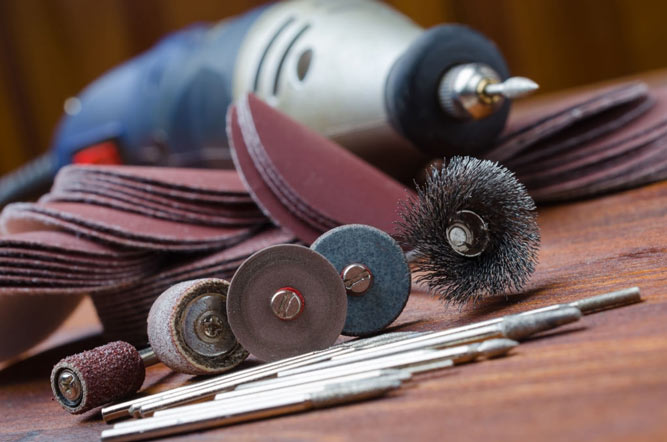From sanding to cutting and scraping to etching and engraving to routing and drilling, there are different types of Dremel bits and their uses also vary.
Here is a complete guide to make things easier for you!
Dremel Bits and Their Uses
1. Sanding bits
Sanding bits are the most popular dremel bits of all. They are used to hone, polish, or enhance different materials like rock, metal, wood, clay, plastic, or even glass.
There are two types of sanding bits –
a) Drums
Drum bits resemble real-world drums with the skin off the top. They have a round cylinder shape.
First, you attach the drum to the end of the tool and slip up the sanding band onto the drum. Abrasive particles are glued on the band to sand down the substance. Drum bits help you sand large surfaces.

b) Discs
These discs are used for precision sanding. Simply attach the sanding disk to your rotary tool and polish your fine work.
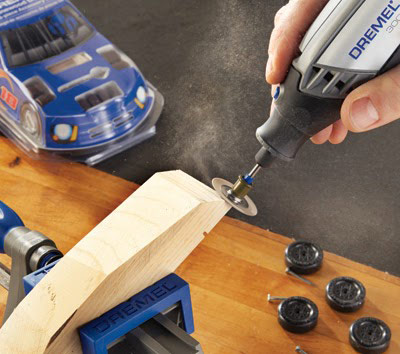
User Guide for Sanding bits
For wood, glass, & metal
You can sand down various woods, glasses, and metals with sanding bands and discs. But help yourself and do a bit of research on which one might suit certain kinds of materials best.
Rust Buster
These rotary sander bits give you more functionality and better results than traditional sandpapers when it comes to rust removal.
Eradicate obstinate marks
You can use sanding bits to get rid of the marks and scars you don’t like to see on your projects.
Shape up creative figures
Sander bits make your arts and crafts shiny and flawless. You can use them in the beginning and the last part of the project.
2. Cutting & Scraping bits
Dremel cutting bits mostly come in the shape of discs and are applied for an accurate cut. But there are special purpose bits for various shapes and designs such as double, single, or diamond cuts for your lavish projects
They’re widely available for cutting through different materials and you’ll find them in all shapes and features. You can do the scraping like an artist with some of these cutting bits if you know how to handle them correctly.
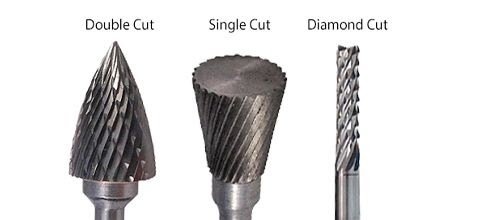
User Guide for Cutting & Scraping bits
Multi-type cuts
In range and variety, no other kind comes in the way of cutting & scraping bits.
To cut a small piece of wood or resize a metal tube, rip off a plastic structure or cut through a thin grout; you can use the cutting bits accordingly.
Ornamental Work
Artists use these cutting and scraping bits for decorative applications like slicing a tile in a unique way that otherwise may seem impossible or carving a lion out of a rough rock.
If you are interested in woodworks and clay carving, you’ll have a whole new experience when giving these awesome tools a try.
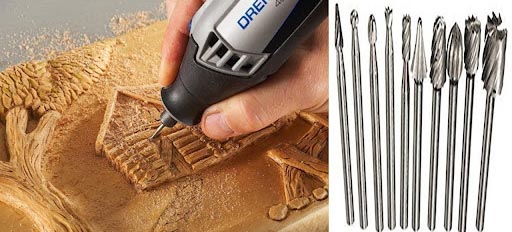
3. Etching & Engraving bits
Dremel tools are remarkable when you need to carve, etch, engrave or decorate something.
The major advantage that the Dremel bits have is in their size. Being small yet handy, they allow you to engrave and etch with absolute precision.
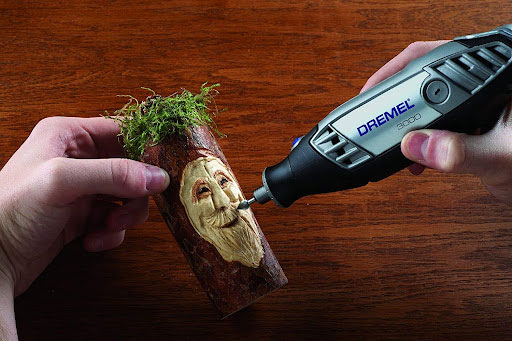
User Guide for Etching & Engraving bits
Take the bit of your choice and put it onto your Dremel’s end. Be sure to rough work them before you start because you could be in trouble finding the right bit to work with.
Etching & Engraving bits are fantastic to groove and slit woods, plastic, and metal. They work best with ceramic-and glass-like materials.
These bits let you be creative and productive in all your wood and metal artwork. Diamond-headed Dremel bits are excellent for engraving glass and stones.
4. Routing & Drilling bits
The unparalleled versatility of Dremel tools is simply amazing. Not only cutting, polishing, and engraving, you can go beyond with the routing and drilling bits no matter the work you’re into.
With the wide variety of drilling and routing bits available, it wouldn’t be difficult for you to pick the right ones up.
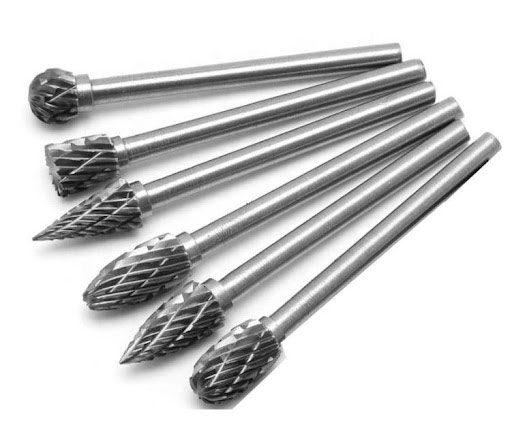
User Guide for Routing & Drilling bits
Artisan or DIY enthusiast, everyone has some drilling to do every once in a while. Dremel tools come in handy when you need to drill through a wall to install a plug by screwing, or to route through a fiberboard.
5. Grinding & Sharpening bits
You might want to keep some grinding and sharpening bits in your toolbox to get your knives and scissors whetted up or grind your ax.

a) Grinding wheels
Grinding wheels are abrasive discs often made of aluminum oxide or other harsh substances, and they come with a comparably thin cross-section than a diameter.
They are useful to help keep your old ax or shine up that door handle. You may also use them for removing rust from flat metal surfaces.
b) Grinding Stones
Grinding stones come in many shapes and sizes. Since the wheels are for the flat part, the stones are for the sharp edge. You can use them for sharpening other bits as well.
6. Mandrel Bits
Dremel has some bits called mandrels that work as intermediary parts. They wear out and needs changing frequently.
User guide of mandrel bits
There are different versions of mandrel bits. Here are some of themost commonly used mandrel bit numbers and their purposes.
#401 – to secure polishing pads
#402 – to hold flat sanding disks and cut-off wheels
#SC402 – to hold cut-off wheels
#407 – to hold sanding bands
#430 – to hold sanding bands
7. Cleaning & Polishing bits
It’s astoundingly breathtaking what you can do with your Dremel cleaning and polishing bits.
Like other bit options, they also come in different shapes, sizes, and materials; and they serve various purposes. Brushes, wheels, and scrubbers are the most notable among them.
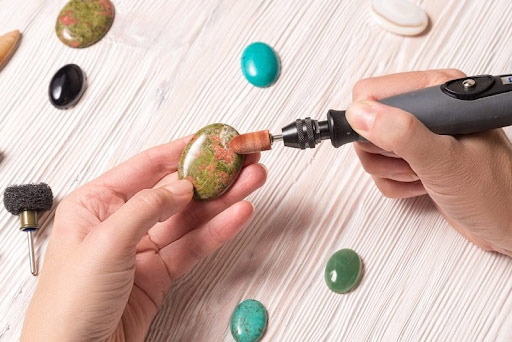
User Guide for Cleaning & Polishing bits
For shiny metals
With Dremel bits, you can clean hard and soft metals and make them look new.
They are broadly used in cleaning and polishing home improvement items like old tools, kitchen and bathroom fittings like taps and sinks, door handles, and all other things; an old watch for instance.
What’s more, you can polish almost every metal like iron, steel, brass, aluminum, bronze, and copper.
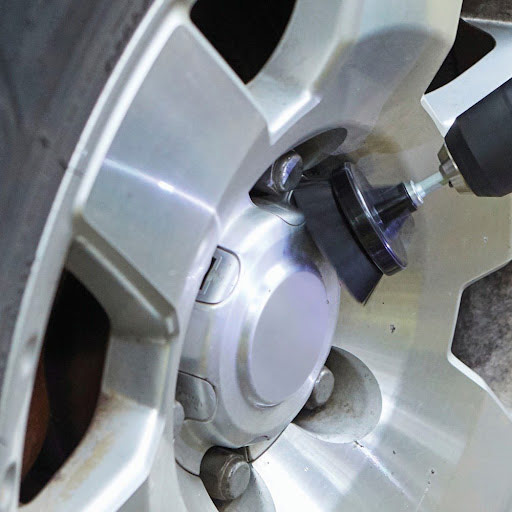
For Antiques & Jewelry
Clean any burr, rust, dust, dirt, unwanted coating, and oxide layer to see the magic happening before your eyes!
If you have old coins, jewelry, and antiques that need some touch-ups, the cleaning and polishing Dremel tools will save you both time and effort.
Soft wheels and cleansing brushes are exactly what you need to make things clear and polished.
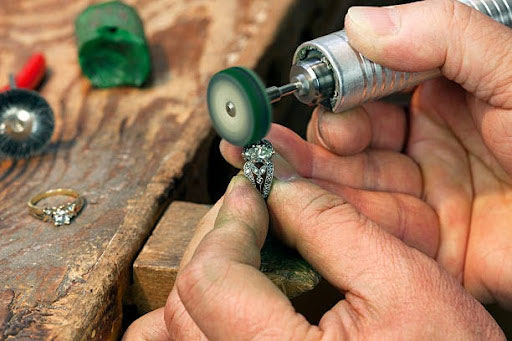
Extravagant Art Ideas
Only a true artist can unleash the real potential of Dremel tools. From engraving to polishing, if you know how to do it and what bits to use, your work will be an adventure with fine outcomes.
FAQs
1. Can you cut thin wood with a Dremel?
Ans: Yes! You can cut thin and small pieces of wood with a Dremel. Since Dremel tools are smaller compared to other saws, it’d be best that you only cut woods that are less than two inches thick.
2. Can you cut a 2×4 with a Dremel?
Ans: You better not try to cut a 2”x4” with a Dremel but you can use it to fine trim them if you like. As Dremel tools are for small-scale tasks and precise use, you can easily cut off thin pieces.
3. Can you use a Dremel as a screwdriver?
Ans: Yes! Dremel Driver is claimed to be “the most fully-featured compact power screwdriver on the market.” And you can also find the screw bits in the market that will get you going.
4. What Dremel bit do I use to carve wood?
Ans: There are different types of bits that can be used to carve wood but the best options would be…
- Tenfer large burr cutter
- 117-speed cutter
- 107?” shank
- 196 carvings/speed cutter
5. Can Dremel engrave metal?
Ans: Yes, there are Dremel bits available for metal engraving. You can do some distinctive engraving designs to make your matal product stand out in the market. This can also help you adapt to your customer’s request.
6. What bit to use for engraving metal?
Ans: Diamond bits are perfect for engraving in metals like aluminum and steel as they are durable and provide better results.

